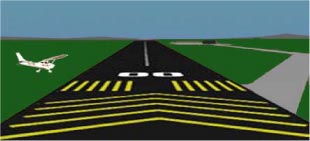 |
||||||
|
|
Number
287
|
August 2003
|
||||
|
P.O. Box 189, Moffett Field, CA 94035-0189 |
||||||
|
|
||||||
 |
||||||
|
|
Number
287
|
August 2003
|
||||
|
P.O. Box 189, Moffett Field, CA 94035-0189 |
||||||
|
|
||||||

 Many
pilots consider visual approaches to be less demanding than instrument
approaches flown in poor weather conditions. But visual approaches can
present a number of hazards, particularly when localizer and glide slope
indications are not used to backup visual impressions.
Many
pilots consider visual approaches to be less demanding than instrument
approaches flown in poor weather conditions. But visual approaches can
present a number of hazards, particularly when localizer and glide slope
indications are not used to backup visual impressions.
As
these pilots reported to ASRS, a low altitude alert can be an unexpected
reminder to get "back up" on the proper visual approach path.
Drifting in a Haze
A controller's warning confirmed that this MD-88 flight crew should have relied more on what the instruments indicated than on what they thought they saw outside.
A Peak Experience
After clearing a desert peak, this B737 Captain was able to offer some sage advice on visual approaches.
An Alert Controller's Alert
Glide slope information was in this B737 flight crew's backup plan, but not in their scan.
We informed the controller that we should be able to fly a visual if we could get a turn toward the field. The controller gave a descent to 2,000 feet and a turn inbound to intercept the localizer. I immediately began to configure the aircraft while in a descending right turn to final. The Captain called the field in sight. I slightly overshot the localizer while looking for the field and the controller gave us a right turn to re-intercept. I saw a reddish-white light ahead which I thought was the Visual Approach Slope Indicator (VASI) for Runway12L, but I could not see the runway lights. The controller asked us again if we had the field in sight and then advised that he was getting a low altitude warning on our flight path.... I quickly leveled off. We were at 1,000 feet, four miles from the airport. I then saw the runway lights and continued for an uneventful landing.
Lessons learned: Don't attempt to fly a visual approach unless the field is in sight.... Maintain the glide slope.
I was so fixated on configuring the aircraft, looking for the field, and maintaining the localizer course that I dropped the glide slope out of my crosscheck....
A Lofty Illusion
With
no visual approach aids or instrument backup, this DC-10 flight crew
was drawn into the "black hole" effect on final.

Cross-checking the instruments on visual approaches can do more than confirm the proper approach path, the procedure can also assist in selecting the right place to land.
"Just a Visual Approach"... to the Wrong Airport
In the following report, a CL65 First Officer was concerned about being high on final, but the instruments indicated that there was also another problem.
Right Base, Wrong Airport
A B737 crew reported on the hazards of a common meteorological phenomenon- the sunny, clear day.
We were on vectors to the right base for a visual to Runway 19. I called the field in sight and fully configured the aircraft. As we were turning to final, Tower advised that we may be looking at the [Wrong] Airport and called the [Right] Airport's position to us. At this point I discontinued the approach, climbed up to 2,000 feet and proceeded to the Outer Marker for an uneventful landing at the [Right] Airport.
Although there were numerous navaids to alert me to my loss of situational awareness...I saw what I expected to see.... It would have become obvious that the runway I was looking at didn't correlate with my ILS, but the Tower and my First Officer spoke up first. This event just reinforced the dangers of complacency on a sunny, VFR day and the importance of crew assertiveness during flight deviations. Quick action on the Tower's part made this more of a professional embarrassment than a real incident.

 Some
Callback readers might be tempted to think, "That could never happen
to me" when readinga report on what appears to be an "obvious"
error. Professionals know better. Mistakes can happen to anyone. Take
this report from a private pilot who didn't notice the difference between
a 13,300 foot military runway and a 4,500 foot municipal strip. It could
happen to anyone. Well...almost anyone. One thing is certain, it won't
happen to this pilot...again.
Some
Callback readers might be tempted to think, "That could never happen
to me" when readinga report on what appears to be an "obvious"
error. Professionals know better. Mistakes can happen to anyone. Take
this report from a private pilot who didn't notice the difference between
a 13,300 foot military runway and a 4,500 foot municipal strip. It could
happen to anyone. Well...almost anyone. One thing is certain, it won't
happen to this pilot...again.
![]()
The Wrong Parts
This sampling of ASRS reports dealing with the installation of wrong parts indicates an ongoing problem. Factors cited in these incidents include failure to verify part numbers, lack of training, schedule pressure, and failure to update illustrated parts catalogs and job cards.
|
ASRS
Recently Issued Alerts On...
|
|---|
| BE90 dual engine flame out |
| NACO chart milage discrepancy |
| SAAB 340B loss of main hydraulics |
| MD80 dual engine generator failures |
| NOTAM confusion at an Eastern airport |
|
July
2003 Report Intake
|
|
|---|---|
| Air Carrier/Air Taxi Pilots |
1,993
|
| General Aviation Pilots |
811
|
| Controllers |
40
|
| Cabin/Mechanics/Military/Other |
164
|
| TOTAL |
3,008
|